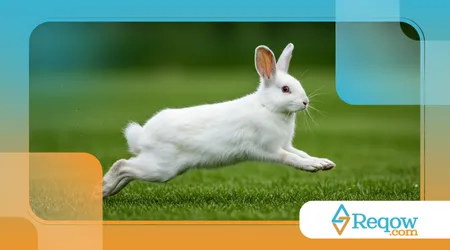What does it mean when a rabbit kicks its hind legs? Understand the behavior

Anyone who lives with rabbits knows they have a very unique way of communicating. Unlike dogs and cats, which use more obvious vocalizations and expressions, rabbits express themselves with body gestures that often go unnoticed by first-time owners.
Advertisements
One of these behaviors, quite intriguing, is when the rabbit kicks with its hind legs.
This gesture may seem like mischief or something random. But it actually has meaning—and can be an important signal about how the animal is feeling. It can indicate frustration, fear, alertness, or simply an attempt to ward off something that's bothering them.
The big question many tutors ask is: “Is my rabbit mad at me?” The answer requires a little more body reading.
Let's take a deeper look at what this movement means, when to worry, and how to better interpret the signals your rabbit is trying to convey.
Advertisements
By understanding behavior, the relationship between you and your pet becomes more fluid and respectful — after all, those who love learn to listen to even the most subtle gestures.
Rabbit body language and the role of hind legs
Rabbits are silent but extremely expressive animals. Even though they don't make audible sounds often, they are always communicating—whether with their ears, whiskers, tail, or hind legs.
When a rabbit kicks once or twice with its back feet, it is trying to push something away.
In nature, this gesture serves as a form of defense: it warns predators that the animal has noticed their presence and is ready to flee. At home, however, the kick can convey different messages depending on the context.
For example, when picked up against their will, many rabbits react by kicking to escape. It can also happen after brushing or cleaning—as if saying, "Enough, human." If they turn away and kick as they leave, they're probably upset about something you did.
This subtle language is even more important because, according to a survey by House Rabbit Society, about 70% of coexistence problems between rabbits and humans arise from misinterpreting body language. In other words, the key to good coexistence is paying attention to these signals.
Common situations in which a rabbit kicks with its hind legs
Every movement of the rabbit tells a story. And to correctly interpret the kick with its hind legs, it's necessary to observe the environment, the sequence of actions, and the posture of the entire body.
After a moment of manipulation
Imagine you're trying to brush your rabbit's fur or clean its paws with a damp cloth.
He looks uncomfortable, squirms a bit, and when you let go, he quickly pulls away and kicks once or twice. In this case, the gesture indicates irritation. It's like saying, "I don't like that."
Even if the intention is good, if the animal isn't used to handling, it may feel invaded. Ideally, this type of interaction should always be done affectionately, in short steps, and reinforced with positive rewards.
Read also: Domestic Rabbits: Are They Really Easy to Raise?
When exploring a new environment
If your rabbit is exploring a new room or garden and kicks the air or the ground, it may be showing a mix of excitement and alertness.
He is testing the environment, letting you know he is present, and staying prepared to flee if necessary.
It's important to give your dog space and time to adapt to unfamiliar surroundings. This behavior is natural, but it shows that your dog is still alert.
After being startled or hearing loud noises
If a rabbit hears a loud knock, a scream, or a door closing, and responds with one or more kicks before running for cover, the signal is clear: fear. It's warning that something has bothered it and that it intends to protect itself.
This reaction is common because, in nature, rabbits are prey animals—and their flight instinct is very strong. Sudden noises trigger this mechanism. Therefore, calm and predictable environments are essential for the animal's well-being.
When should you worry about this behavior?
In general, kicking with hind legs is normal and even expected behavior in healthy rabbits. However, when it becomes frequent or aggressive, it could be a sign that something is wrong with the pet's environment, health, or routine.
For example, if your rabbit starts kicking every time you approach, it may be associating your presence with negative experiences.
This requires reevaluating how you're interacting with him. Another possibility is physical pain, especially if he's also avoiding touch or exhibiting more withdrawn behavior.
A real-life case illustrates this situation well. Júlia, Chico the rabbit's owner, noticed that he started kicking whenever she tried to pet him.
After taking him to the vet, he discovered that he was experiencing discomfort in his hind legs due to the lack of adequate support in the cage.
Replacing the floor with a softer rug solved the problem. This shows that kicking isn't often a sign of rebellion, but rather a way of asking for help.
How to improve coexistence with an expressive rabbit
When we understand a rabbit's body language, our routine changes completely. Trust grows, time together becomes more relaxed, and even affection becomes more frequent.
And if you still feel unsure about what you're doing wrong, remember that No one is born knowing how to deal with such a sensitive animal — it's a mutual learning process.
A good analogy would be to say that a rabbit is like an introverted roommate: he needs time, space, and respect to open up.
And when he feels safe, he begins to show affection in unique ways, like lying next to you or purring softly.
Another key point is respecting the animal's boundaries. Not all rabbits enjoy being held, and forcing this interaction can lead to further distancing.
With patience, positive reinforcement, and freedom, the bond strengthens. The good news? When he realizes you respect his space, the rabbit himself begins to seek contact more frequently.
Frequently Asked Questions About Rabbit Kicking with Hind Feet
1. Do rabbits kick as a joke or is it always a negative sign?
It's not always negative. It can be a response to excitement, fear, or frustration, but it can also simply be a spontaneous gesture during play.
2. Is it dangerous when the rabbit kicks hard when held?
Yes, your child could get hurt or fall. So, hold your child firmly and carefully, always supporting their entire body, and avoid picking them up if they show discomfort.
3. How do I know if my rabbit is angry or scared?
Observe the overall behavior. If he kicks and hides, he's probably scared. If he kicks and ignores you or turns his back, he may be angry.
4. Can kicking indicate pain or a physical problem?
Yes, especially if the behavior appears suddenly or is accompanied by other signs, such as apathy or difficulty walking.
5. Should I correct this behavior or just accept it?
Never correct with scolding or punishment. The ideal is to understand the cause and adjust the environment or way of interacting to make coexistence more respectful and peaceful.
